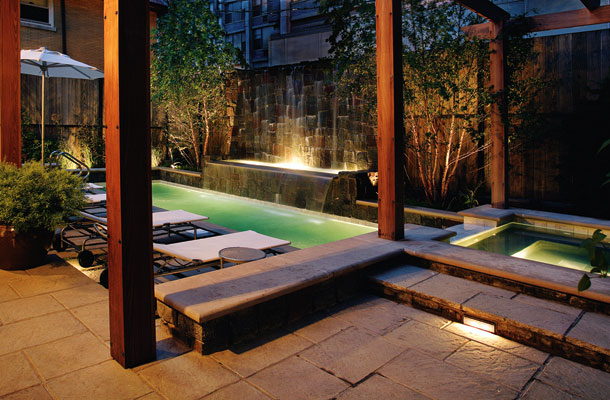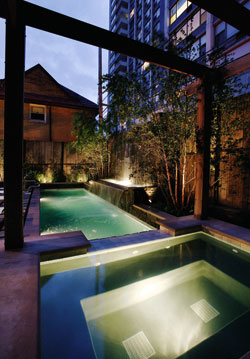 |
|
Step up to the hot tub, down to the pool; the simple layout of the yard breaks into “rooms” at different levels. |
 |
|
Sound, light, and architecture work together to create a secluded retreat (complete with waterfall) in a very urban neighborhood. Vines trained to grow over the pergola will soon create a ceiling, for even more privacy. ::: View Photo Gallery |
In most homes, reaching for the remote marks the start of an evening spent in front of the television. But when Robert Kroupa grabs a remote to turn up the volume, he’s adjusting the water speed of his backyard waterfall.
He may like it extra-loud if there is lots of background noise coming from his Uptown neighborhood or Lake Shore Drive, half a block to the east; he might turn it low if the evening is quiet. Whatever setting Kroupa chooses, the water cascading down the craggy granite-block wall, which stands ten feet high and 15 feet wide, creates a sound curtain that separates his slim back yard from its surroundings.
It’s just one element in a layered landscape design that effectively isolates the space behind Kroupa’s graciously rehabbed house on historic Hutchinson Street. The feeling of privacy also comes from outdoor lighting that subtly masks views beyond the yard, and a handsome pergola that within a few years should be covered with vines.
Together, sound, light, and greenery create walls, making Kroupa’s outdoor living space feel as sheltering as the indoor space it connects to. A real estate developer, movie producer, and head of a small consumer products company, Kroupa is nothing if not enterprising. “I wanted the family room and the backyard to open up and all feel like one big wide-open space,” he says. Open the French doors along two sides of the family room at the rear of the house and you’re in a seamless indoor-outdoor zone.
As designed by David Migdal of The Garden Consultants in Northfield, this is not a garden but a pair of rooms for living outdoors when the temperature cooperates. Ground-level plants are, for the most part, accessories to the larger picture (though they will become more of a focal point as they grow in).
Filling what would typically be the backyard space, just 31 feet long and 50 feet wide, is the pool room, where a saltwater lap pool, a hot tub, and the waterfall provide multiple layers of pleasure. (One reason swimming pools are so rare in city back yards is the lack of truck access to the rear. This pool was dug by hand.)
Two river birches frame the water wall; they are the only plants that play a major role in the composition. Their peeling bark works beautifully with the rough texture of the waterfall.
Around the corner, in a small side yard created by an elbow in the house’s footprint, there’s an outdoor sitting room, with a couch and chairs facing a fireplace. The inviting hearth promises that this room will get some cold-weather use, so Migdal edged part of it with evergreen yews; their foliage will keep the feeling of enclosure going in a cool season.
A pergola made of tough and renewable ipe wood wraps the house, pulling the two outdoor rooms together and, eventually, providing a “ceiling’’ in the form of vines that are now just getting started. While a suburban outdoor living area might get along fine without a top, here it’s needed. Behind Kroupa’s house is a 28-story residential building; vines will interrupt views by its residents into his yard, but in a neighborly way, just as the sound of the waterfall baffles noise without adding to the cacophony.
Both of those elements also keep the attention of Kroupa and his guests within the confines of his property, and the placement of outdoor lighting is intended to do the same. “We have uplighting in the trees and gentle illumination of the garden to keep you from seeing out,” Migdal says. “You don’t need a lot of light at night to see, especially in the city, but you can use the lights like a screen.”
Photography: Linda Oyama Bryan
Related:



